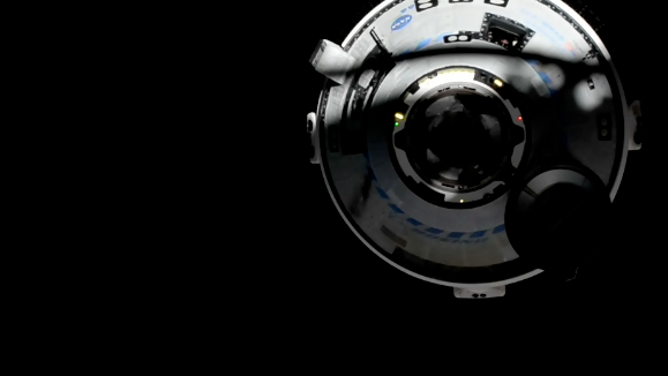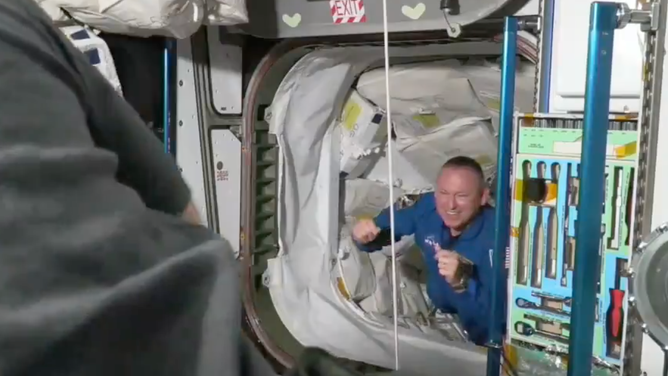Boeing Starliner spacecraft docks at ISS with NASA astronauts after dramatic approach
NASA Astronauts Butch Wilmore and Suni Williams are the first to test flight on Starliner after launching from Florida on Wednesday. After 24 hours of spaceflight, Beoing Starliner began approaching the International Space Station for docking but a series of malfunctions with thrusters delayed the docking.
Boeing Starliner launches 2 NASA astronauts into orbit for first time
ULA's Atlas V rocket launched on Wednesday morning from Florida sending the first Boeing Starliner capsule with crew into orbit. NASA Astronauts Butch Wilmore and Suni Williams are conducting the crew flight test of Starliner and will spend about a week at the International Space Station.
NASA astronauts encountered problems with Boeing's Starliner spacecraft on Thursday before finally docking at the International Space Station in the early afternoon, creating a dramatic final approach to their destination.
NASA astronauts Suni Williams and Butch Wilmore began the Crew Flight Test (CFT) of Starliner by launching on United Launch Alliance’s Atlas V rocket from Cape Canaveral on Wednesday at 10:52 a.m. ET. Docking at the ISS achieves one of the final milestones before NASA certifies Boeing to fly humans on long-duration missions.
After 24 hours of spaceflight, Starliner began approaching the International Space Station for docking around 10 a.m. ET Thursday, but a series of malfunctions with thrusters delayed the docking as the astronauts completed testing in orbit.
BOEING STARLINER LIFTS OFF FLYING NASA ASTRONAUTS FOR FIRST TIME
Boeing and NASA have worked on issues with the spacecraft throughout the journey to the space station, including problems with jets and two new helium leaks.
A helium leak on the spacecraft delayed the CFT launch into June, but NASA and Boeing teams determined the leak was within safety limits and moved ahead with the mission. However, the leak ahead of liftoff was in one area and throughout the spaceflight, teams on the ground discovered two new helium leaks on the spacecraft.

A NASA and Russian crew welcome NASA astronauts Butch Wilmore and Suni Williams to the International Space Station after arriving in Boeing Starliner on June 6, 2024.
(NASA)
Three helium manifolds were closed on the spacecraft during the spaceflight to manage the leaks and reopened for docking.
SPACEX'S STARSHIP AND SUPER HEAVY BOOSTER MAKE EPIC SPLASHDOWNS IN GULF OF MEXICO, INDIAN OCEAN
"The flight control team will continue to monitor the leak rates in Starliner’s propulsion system. After docking, all of Starliner manifolds will be closed per normal plans," NASA said.
Dramatic approach to docking
A new issue with the spacecraft's thrusters ultimately delayed Starliner's final approach to the space station.
NASA said sensor values on multiple reaction control system (RCS) thrusters used to move the spacecraft in orbit registered slightly above normal limits.
NASA had Williams complete hot fires of four problem jets to get them functioning again before moving ahead with docking. While this testing was underway, Wilmore took over manual control of the spacecraft. The thrusters were fired for a second time before the issue was resolved enough for approach.

A view of Boeing's Starliner spacecraft from the International Space Station as the vehicle comes in for docking on June 6, 2024.
(NASA)
After holding 200 meters from the ISS for about an hour, NASA gave Starliner the go-ahead to begin its final approach to the orbiting laboratory.
Wilmore and Williams were scheduled to dock at the ISS around noon, where five astronauts and two cosmonauts were there to greet them and the Starliner spacecraft named Calypso. With the delay, the first contact with the space station happened around 1:34 p.m.
"It's nice to be attached to the big city in the sky," Wilmore said after docking. The veteran astronauts joked they would call their arrival the "big-time approach."
The arrival marks the first time Starliner docked at the orbiting laboratory with astronauts and the first time three human-rated spacecraft have been docked at the ISS simultaneously. The company completed a previous flight test without crew in 2022.
What's next for Starliner?
Wilmore and Williams were welcomed to the International Space Station around 3:20 p.m. by their fellow ISS crew.
Williams was first through the Starliner hatch, followed by Wilmore. They both showed their excitement to be on the station after a 25-hour journey with hugs to the other astronauts.

NASA astronaut Butch Wilmore floats through the Starliner hatch to the International Space Station on June 6, 2024.
(NASA)
Both astronauts are retired U.S. Navy captains. As part of a Navy tradition, the crew rang a bell as Williams and Wilmore entered the space station.
"I’m not sure we could not have gotten a better welcome," Wilmore said.
The astronaut pair will spend about 8 days on station before returning to Earth in Starliner. NASA managers said the return timeline is flexible, and the date could change by a few days.
Since liftoff, views inside the spacecraft have not been available because of Starliner's software capabilities. Now that the spacecraft is at the space station, Boeing managers said video inside the capsule will be downlinked to Earth.
"Once we do get the station, we'll get feed. And, of course, when we get back down, we'll be able to get all the video. We are looking at being able to provide live feed in flight, but that won't be for a couple of flights," Boeing’s Commercial Crew Program manager Mark Nappi said after the launch.
The final part of the CFT will be a successful landing in the New Mexico desert, which will return Williams and Wilmore safely home.
